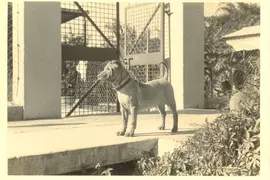What is a real traditional Shar Pei?
After posting the logo of the Dali Shar Pei club on social media yesterday, that was designed in 1996, I recieved a question about it. A question I was hoping to get. I have decided to answer the question here, as it might clear up many misconceptions.
Question
I was asked why the head of the dog on the logo looks like a meatmouth Shar Pei and does not resemble the dogs I usually post from dogs in China. I was further asked, if this picture is used, what is then a real traditional Shar Pei?
The short answer is: There is no traditional Shar Pei! The meaning of the chinese term "traditional Shar Pei" is very different to the meaning of the same term we have in in the western world. While the term in the West is used more like a marketing sign to make differences between types of dogs, the chinese meaning just referes to the fact that the breed is old, has a historic meaning and belongs to the chinese tradition. This is the reason why I never use this term. To prevent misinterpretations.
The misconception of this term is causing a lot of confusion. It gave ground to the "what is right, what is wrong" question. To understand the breed, we have to look at three important factors:
- Genetics
- History of the breed in Hong Kong
- History of the breed in China
Genetics
Thanks to modern science we know the underlying genetics well enough to understand the different appearences. We know that in all SharPeis, Chinese and Western, a mutation of the regulatory gene HAS2 on chromosome 13 is present at least twice. We know that the higher the number of copies of the mutation, the higher is the formation of hyaluronic acid, which accumulates in the tissue. This mutation is present as a so-called CNV (Copy Number Variation), which means that the number of mutations in the individual varies. In all Shar Pei, we can find it at least twice, but may also be present in higher numbers. The more copies that are present, the higher the activity of HAS2 and the more hyaluronic acid is formed and incorporated as a basic substance into the tissue. The skin becomes fainter, thicker, contains more water and produces more wrinkles and a characteristic thick muzzle.
There is no right or wrong. There is just a difference in copy numbers. This is a very important fact to understand the breed.
What we do not know at the moment is the answer to the question when the mutation originally occured. We also do not now yet how and why the original mutation, of a double copy number, mutated further. But these questions are important to answer and scientists are trying to answer this question already with further genetic research.
China and Hong Kong
When talking to older knowledgable and experienced Shar Pei enthusiasts in Hong Kong and in China about the breed in the 1960s and 1970s, we see differences. Before this time, there was no organized pure bred Shar Pei breeding. Just few older people, like Huang ZhaoTao and Zhao Qi, could tell more about the breed typical characteristics.
We know that most dogs in Hong Kong at that time were no pure bred Shar Pei. Before the mid 1960s the dogs were mainly used in dog fights, crossbred with every dog that gave more agression to the breed to make it win in the pit. They were even called "the chinese fighting dog". Those were the foundation dogs of the early breeders in Hong Kong. And they tried to do their best to get to pure bred Shar Pei. And they did it all without the genetic knowledge we have today. They did is only by closely observing the dogs. The early breeders of pure bred Shar Pei were and still are against any kind of dog fighting and just cared for the breed itself.
In China at the same time we had a different situation. There is the traceability of a Shar Pei population that spanned all southern Chinese provinces up to this time. Interestingly, with two geographic focuses, southern Guangdong and the northeastern part of Yunnan, between Sichuan and Guizhou. As almost all of those populations have disappeared, most knowledge we have of the population in the Guangdong area. Same as in Hong Kong, there was almost no pure breeding. Shar Pei were bred to serve a porpose, crossbred with other local breeds to better serve their purpose. And while in Hong Kong this purpose was mainly getting agressive dogs for the pit, in China there were different ones. Getting better hunting dogs, getting better guarding dogs and also getting dogs better in dog fighting.
The breeds used for crossbreeding in both places were also different. In China mostly with local breeds, while in Hong Kong the variety of dog breeds was already more international.
But in both places there were few people in the 1960s and 1970s that started with pure bred breeding with the goal to preserve and protect the Shar Pei. They just had a different stock of dogs to start with.
Exchange
In 1975 the first people from Hong Kong came to Dali in Gunagdong looking for dogs. But the understanding of the breed was already different at that time. The most basic knowledge about the breed in both places came from Zhao Qi. But already in 1975, the development of personal perspectives had already started developing in different directions. The Shar Pei in Hong Kong and China showed differences, which should correspond to the own picture and the own idea of the breed. We always have to keep in mind that on both sides of the border breeder started with a different set of genetic pool due to the different breeds that were used for crossbreeding before there was pure breeding. This is important, as it helps to understand, why there is no right or wrong. Just a different initial situation.
But why did the dogs differ? And what was the difference?
Meatmouth creation myth
There are people in the West, in Hong Kong and in China, who still believe in the made up story of "someone created the meatmouth". Even now, with our genetic knowledge, those false stories circulate and are used by some people to push the "right and wrong question". If we see the underlying genetic of the breed for what it is, we can answer this question easily.
We dont know yet what is triggering the 2 copy mutation to mutate further. But for sure nobody did it on purpose, mixing up some genes in a secret laboratory in the 1960s in Hong Kong. It just occured and these dogs were used for breeding. This way the number of meatmouth dogs got higher in Hong Kong and more popular.
That it also came to the spontaneous occurrence of meatmouth dogs in China in the past is known through verbal reports of several older Chinese across the south chinese provinces. Every few years there is a meatmouth puppy in a litter here and there.
Further exchange
In the fall of 1989, some people from Hong Kong brought meatmouth Shar Pei to Dali, and breeding and hybridization with these dogs was promoted. At this time there was no organized breeding and the concept of pure bred breeding was new to many. A handful chinese breeders, that regarded the Shar Pei, as they knew it, as their cultural heritage and thought of ways to protect the chinese bonemouth type then founded the Dali Shar Pei Club. The first president of the club was a man called Yan Runhe. Unfortunatelly he died just a year after the club was founded.
As it was not possible in China at that time to start and run a real private club due to the political system, the club had to follow political guidelines and political strategies.
With the second president most original intentions of the club vanished, economic interests were dominant and political local influence on the club was high. Dog people from Hong Kong gained more influence and the meatmouth Shar Pei was promoted in China even more.
In 1997, Dali's Shar Pei Club and the club in Hong Kong merged. Meatmouth Shar Pei were advertised on radio, television, newspapers and magazines all over China. After years of co-marketing done by both clubs, many false information circulated about the breed. Today many people think that the meatmouth is the only correct type and the bonemouth Shar Pei is almost unknown. Most people do not know or understand the genetics of the dogs, they just see two different types. And one must be right and one must be wrong in their eyes.
In 1996 the Dali Shar Pei Club published his Shar Pei standard and created the logo, that initiated the question I am trying to answer with this article. A standard that reflects mainly the ideas about the breed coming from Hong Kong and not the ones coming from China. The same goes for the logo.
Changes
Since this time some things have changed:
- The Dali Shar Pei Club is now a mostly private club, still a little limited as what they are allowed to do, but the protection of the chinese type is back on their agenda.
- Mutual understanding of the different initial situation, when pure Shar Pei breeding started on both sides of the border, is growing through more exchange
- The genetic knowledge we have today about the breed helps to understand the differend appearences of the breed. And this understanding makes the "right and wrong" question unnecessary.
Conclusion
- A Shar Pei is a Shar Pei as long as it fits the standard and has all its unique characteristics.
- There is no right or wrong.
- A traditional Shar Pei with the meaning we have in the West does not exist, it is just a marketing term used by some.
Future outlook
A wedge was driven into the Shar Pei situation in China and Hong Hong in the past. Now it is time to get it out, to heal and to look into the future. It is time to grow together, to stop fighting and find a mutual way together.
Having all this in mind we have decided to have a Shar Pei conference in China in 2020, organized by the Dali Shar Pei Club and me as a member of this club. We will have speeches and discussions on different topics, from genetics to health, from standard to history, we try to cover all areas. We believe in cooperation as the best way for the breeds future.
Update: Because of Covid, the planned conference was postponed to a yet unknown date, when normal traveling will be possible again.


